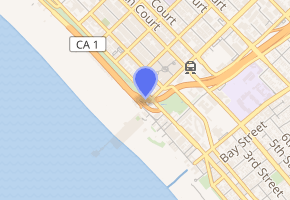McClure Tunnel
The McClure Tunnel is a tunnel in Santa Monica, California, that connects Pacific Coast Highway (State Route 1) to its junction with the western terminus of the Santa Monica Freeway (Interstate 10).[2][3] The tunnel passes through the Santa Monica ocean bluffs,[3] underneath the Colorado Avenue–Ocean Avenue intersection and close to the Santa Monica Pier and southern end of Palisades Park. The length of the McClure Tunnel is about 400 feet (120 m).[1] The current tunnel opened in 1936, replacing an earlier rail tunnel which had been bored in 1886.[3] It was officially named the McClure Tunnel in 1979 after Robert E. McClure, a local newspaper publisher and member of the state highway commission.[4]
 Western entrance of the McClure Tunnel | |
| Overview | |
|---|---|
| Location | Santa Monica, California |
| Coordinates | 34.0114°N 118.4955°W |
| Route | |
| Technical | |
| Length | 400 feet (120 m)[1] |
| Route map | |

| |
California highway status
According to the California State Highway system, the McClure Tunnel is part of State Route 1 in its entirety.[5] The western terminus of Interstate 10/Santa Monica Freeway is to the east of the tunnel when SR 1 turns into a freeway at 4th Street.[6] SR 1 then exits onto Lincoln Boulevard while I-10 continues east to Los Angeles.
History
.jpg)
The tunnel was originally constructed in 1886 as a Southern Pacific Railroad tunnel intended to enable the railroad to take trains to Santa Monica's Long Wharf.[3] This tunnel, and the ocean view to the left that suddenly appears as the passenger moves westward out of the curved tunnel, was depicted in a brief 1898 Edison Studios film called Going Through the Tunnel.[7][8] It was demolished and reconstructed in Works Progress Administration Moderne style as an auto tunnel, known as the Olympic Tunnel and opened in 1936. The tunnel was built at a cost of $200,000 and connected Roosevelt Highway with Olympic and Lincoln boulevards. The freeway connected to the tunnel in 1966, and in 1979 the tunnel was officially named in honor of Robert E. McClure, editor of the Santa Monica Outlook newspaper and a longtime advocate for the freeway.[1][9][10][4]
See also

- California Incline
References
- Harrison, Scott (August 13, 2014). "1936 Tunnel Opening in Santa Monica". Los Angeles Times. Retrieved April 18, 2016.
- "McClure Tunnel Closed Overnight for Caltrans 'Swarm' Operation Targeting Freeway Maintenance" (PDF). California Department of Transport. March 30, 2018. Retrieved November 23, 2018.
- Nathan Masters (April 29, 2014). "The Train Tunnel in This 1898 Film Is Now Part of Pacific Coast Highway". Gizmodo. Retrieved November 23, 2018.
- Jenn Garbee; Stephanie "Tippy" Helper (2007). Hometown Santa Monica: The Bay. Prospect Park Publishing. p. 31.
- California Department of Transportation (February 2017). "Log of Bridges on State Highways". Sacramento: California Department of Transportation.
- Warring, KS (April 18, 2008). "Interstate 10 Freeway Interchanges" (PDF). California Numbered Exit Uniform System. California Department of Transportation. Retrieved February 22, 2017.
The Easterly segment from McClure Tunnel to county PM 2.155 is Pacific Coast Highway SR-1
- Shiel, Mark (2013). Hollywood Cinema and the Real Los Angeles. London: Reaktion Books. p. 28. ISBN 978-1-86189-940-8 – via Google Books.
- White, James H. (1898). Going Through the Tunnel (Motion picture). Edison Manufacturing. LCCN 00694216. Retrieved April 19, 2016 – via Library of Congress.
- Loomis, Jan (2012). Westside Chronicles: Historic Stories of West Los Angeles. American Chronicles. Charleston, SC: Arcadia Publishing. p. 96. ISBN 978-1-61423-739-6 – via Google Books.
- Scott, Paula A. (2004). Santa Monica: A History on the Edge. Making of America. Charleston, SC: Arcadia Publishing. p. 134. ISBN 978-0-7385-2469-6 – via Google Books.